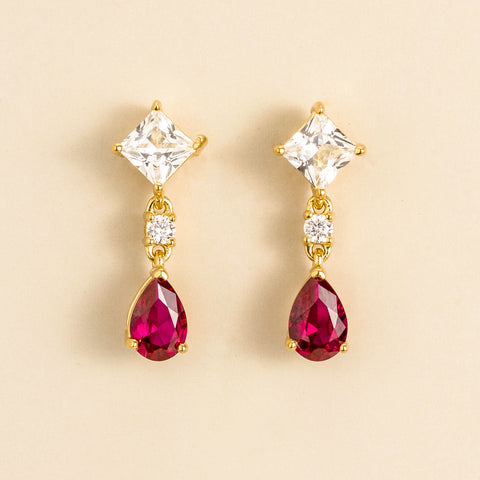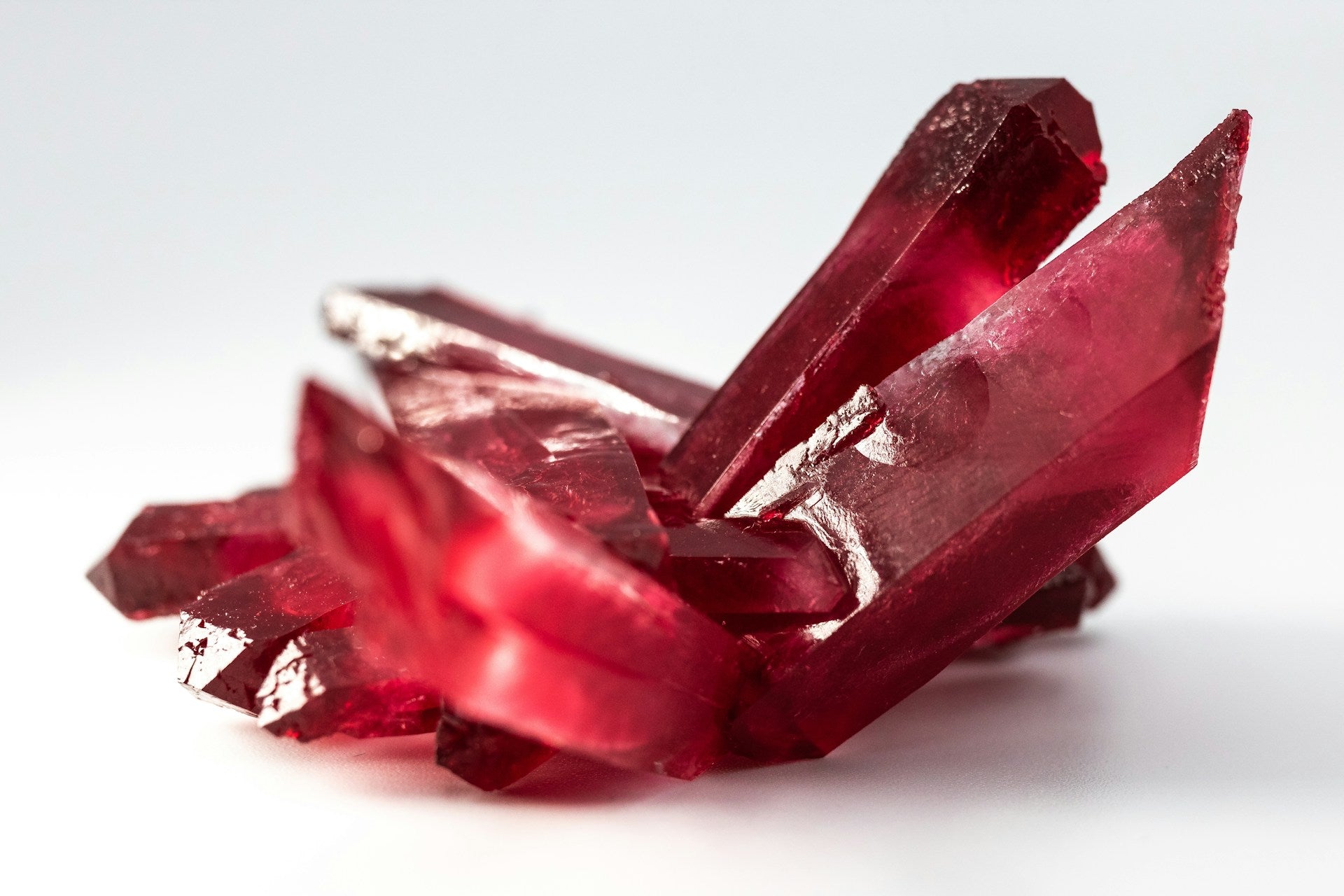
The History of Ruby Earrings: From Ancient Times to Today
Table of Content: Inside this Article
...The Evolution of Ruby Earrings: A Detailed Look at Their Historical and Cultural Journey
Introduction
Who wouldn't want to have sparkling red stones adorning their ears?
Red is mostly every woman's favourite. From wardrobes and even accessories, red is the most sought-after colour. Ruby earrings, in particular, have been a symbol of sophistication and luxury, adorning the ears of royalty, celebrities, and everyday enthusiasts alike. These magnificent gemstones, renowned for their intense red hue, have long held a place of prominence in the jewellery industry. Their rich history, cultural significance, and aesthetic appeal have made them a sought-after accessory for generations.
This article delves into the history of ruby earrings, exploring their origins and evolution over time. We will examine the cultural significance in various societies and discover how they have been interpreted and celebrated across different eras. By understanding the origins and their enduring popularity, we can appreciate the timeless allure of these iconic gems.
Ancient Origins of Ruby Earrings
The Early Use of Rubies in Jewelry
The history of ruby earrings can be traced back to ancient civilizations, where rubies were highly prized for their beauty and symbolic significance. One of the earliest known uses of rubies in jewellery dates back to ancient Myanmar, where the gemstone was believed to have originated. The Burmese people revered rubies as sacred stones, associating them with the blood of the earth.
In ancient India, rubies were also held in great esteem. They were often used to adorn the jewellery of royalty and the wealthy, symbolising power, wealth, and protection. The deep red colour of rubies was believed to have healing properties and was associated with the planet Mars, which was thought to govern passion, courage, and vitality.
Ancient ruby jewellery, including earrings, often featured intricate designs and delicate settings that showcased the beauty of the gemstones. The early use of rubies in jewellery laid the foundation for the enduring popularity of ruby earrings throughout history.
Ruby Earrings in Ancient Civilizations
Rubies in Ancient Civilizations: India, Egypt, and Greece
Rubies have played a significant role in the history and culture of various ancient civilizations. In India, rubies were often associated with the Vedic texts, which describe them as precious gems that could bring wealth, power, and protection. The ruby's red colour was believed to be connected to the planet Mars, which was associated with passion, energy, and courage. Indian royalty and nobility often adorned themselves with ruby gemstones to symbolise their status and power.
In ancient Egypt, their culture embraced the beauty and symbolism of rubies. Rubies are used to adorn the jewellery of pharaohs and other important figures. Ruby jewellery were considered to be symbols of status and power, and they were often worn during religious ceremonies and festive occasions. The intricate designs and craftsmanship of ancient Egyptian ruby jewellery continue to amaze and inspire modern-day jewellers. The legacy of ruby earrings in ancient Egyptian culture has helped to solidify their place as timeless and iconic pieces of jewellery.
Ancient Greece also embraced the beauty and symbolism of rubies. The Greeks associated rubies with the god Ares, the god of war. They believed that rubies could bring courage, strength, and victory in battle. Ruby earrings were often worn by warriors and athletes as talismans for protection and success.
Ruby mythology across these ancient civilizations highlights the enduring appeal and significance of these gemstones. Their association with gods, goddesses, and celestial bodies solidified their status as powerful and precious symbols.
History of Ruby Earrings in Royalty and Nobility
Royal Glamour: The Role of Ruby Earrings in Monarchies
Rubies have long been associated with royalty and nobility, symbolising wealth, power, and status. From ancient kings to European monarchs in the Renaissance and Victorian eras, earrings with ruby elements have adorned the ears of some of history's most influential figures.
Ancient kings and pharaohs often wore earrings with ruby gemstones to demonstrate their divine connection and authority. In the Renaissance, European monarchs embraced the opulence and extravagance of ruby jewellery. The Victorian era saw a resurgence of interest in rubies, with many royal families owning and wearing exquisite ruby jewellery.
Queen Elizabeth II was known for her collection of stunning ruby accessories, which included pieces from various eras and styles. Catherine the Great, the Empress of Russia, was also famous for her love of rubies. Her collection included a pair of large, oval-shaped ruby earrings that were said to be among the finest in the world.
The association of rubies with royalty has helped to cement their status as iconic and desirable pieces of jewellery. The timeless elegance and enduring appeal of these earrings continue to captivate the imagination of people around the world.
Ruby Earrings in the Middle Ages and Renaissance
Medieval and Renaissance Ruby Earrings: Symbols of Status
During the Middle Ages and Renaissance in Europe, ruby gemstones became a symbol of wealth, power, and status. As trade routes expanded and access to precious gemstones increased, rubies became more readily available to the aristocracy and nobility.
Famous historical figures and families who wore ruby made earrings included the Medici family of Florence, the Hapsburg dynasty, and the Bourbons of France. They were often given as gifts between royal families and were considered valuable diplomatic tools. They were also popular choices for engagement and wedding rings, symbolising love, passion, and eternal commitment.
The intricate designs and craftsmanship of mediaeval and Renaissance ruby earrings reflect the artistic sophistication of the era. Many pieces featured delicate filigree work, intricate settings, and stunning gemstones of various sizes and shapes. The popularity of the earrings during these periods helped to solidify their place as iconic and desirable pieces of jewellery.
Cultural Significance of Ruby Earrings
Cultural Symbolism of Rubies Across the World
Rubies have held significant cultural symbolism in various regions around the world. In Asia, rubies have been particularly revered in Hindu and Buddhist traditions. In Hinduism, rubies are associated with the planet Mars, which is believed to govern passion, energy, and courage. The ruby's red colour is often linked to the life force and vitality of the body. In Buddhism, rubies are considered sacred stones that can bring wisdom, enlightenment, and protection.
In Europe, rubies have been associated with love, passion, and desire. They were often given as engagement and wedding rings, symbolising eternal commitment. In some cultures, rubies were believed to have healing properties and were used in traditional medicine.
In Africa, rubies have been used in various cultural ceremonies and rituals. They are often considered symbols of wealth, power, and status. In some African traditions, rubies are believed to protect against evil spirits and bring good fortune.
The cultural significance of ruby earrings extends beyond their beauty and aesthetic appeal. These gemstones have been imbued with deep meaning and symbolism in various cultures around the world, reflecting the enduring fascination and allure of rubies.
Victorian Era: The Romantic Appeal of Ruby Earrings
Victorian Era Ruby Earrings: Love and Passion in Jewelry
The Victorian era witnessed a resurgence of interest in rubies, which were often paired with diamonds or pearls to create stunning and romantic pieces of jewellery. Rubies were seen as symbols of love, passion, and desire, making them a popular choice for engagement and wedding rings.
The intricate designs and craftsmanship of Victorian earrings reflect the era's emphasis on sentiment and emotion. Delicate filigree work, intricate settings, and stunning gemstones were combined to create pieces that were both beautiful and meaningful.
The growing demand for earrings with ruby elements during the 19th century can be attributed to several factors. The Industrial Revolution led to increased trade and access to precious gemstones, making rubies more readily available to the public. Additionally, the Victorian era's emphasis on sentiment and emotion made ruby earrings a popular and desirable choice for jewellery lovers.
20th Century Ruby Earrings
The Modern Era: Ruby Earrings in 20th Century Fashion
Ruby earrings continued to evolve and adapt to changing fashion trends throughout the 20th century. The Art Deco period (1920s-1930s) saw a resurgence of interest in geometric shapes and bold designs. They often featured geometric motifs, vibrant colours, and striking settings.
The Hollywood glamour of the 1950s and 1960s popularised large, statement earrings. They were frequently seen on the ears of iconic movie stars, adding a touch of luxury and sophistication to their glamorous looks.
As the 20th century progressed, ruby earrings continued to evolve. The 1970s brought a bohemian aesthetic, with chunky, bohemian-style earrings featuring natural gemstones, including rubies. The 1980s saw a return to bold, statement earrings, often featuring large, colourful gemstones.
In the late 20th century and early 21st century, they remained a popular choice for both casual and formal wear. Modern designs often incorporate a mix of traditional and contemporary elements, resulting in a wide range of styles to suit different tastes and preferences.
Famous Ruby Earrings in History
Famous Ruby Earrings Worn by Icons and Celebrities
These marvellous earrings have been worn by some of the most iconic figures in history, both past and present. In addition to royalty, celebrities have also embraced the allure of the earrings, adding a touch of glamour and sophistication to their style.
Elizabeth Taylor was famous for her stunning collection of jewellery, including a pair of exquisite ruby earrings. These earrings, known as the "La Peregrina Rubies," were once part of the Spanish Crown Jewels and were later owned by actress Ava Gardner before being acquired by Taylor.
Other notable celebrities who have been seen wearing earrings with Ruby elements include Kate Middleton, Jennifer Lopez, and Rihanna. They have also made appearances in popular movies and television shows, adding a touch of luxury and elegance to the characters who wear them.
The enduring appeal of the earrings is evident in the continued fascination that they hold for celebrities, fashion icons, and jewellery enthusiasts alike. These iconic gemstones continue to captivate hearts and minds, symbolising timeless beauty, luxury, and sophistication.
The Evolution of Ruby Craftsmanship
From Handcrafted to Modern: The Evolution of Ruby Earring Craftsmanship
The techniques used to cut, polish, and set rubies in earrings have evolved significantly over time, reflecting advancements in technology and craftsmanship. In ancient times, rubies were often cut and polished by hand using simple tools. The process was labour-intensive and could result in some loss of the gemstone's weight and value.
As technology advanced, new techniques for cutting and polishing rubies were developed. The invention of the lapidary wheel in the 15th century revolutionised the process, allowing for more precise and efficient cutting and polishing. In the 20th century, the development of lasers and other advanced technologies further refined the art of ruby craftsmanship.
Modern ruby earrings often feature intricate designs and delicate settings that would have been impossible to achieve using traditional handcrafting methods. Laser cutting and engraving techniques allow for precise and detailed work, while advanced polishing methods ensure that rubies retain their lustre and brilliance.
The evolution of ruby craftsmanship has contributed to the enduring popularity of ruby earrings. The ability to create stunning and unique pieces has made this ruby jewellery a sought-after accessory for people around the world.
The Value and Rarity of Historical Ruby Earrings
Historical Value: The Rarity and Significance of Ruby Earrings
Historical ruby earrings are often considered timeless heirlooms, prized for their beauty, rarity, and historical significance. The value of these earrings can be influenced by several factors, including:
- Age and Provenance: Older earrings with a documented history and traceable provenance tend to be more valuable.
- Gemstone Quality: The quality of the rubies used in the earrings, including their colour, clarity, and cut, significantly impacts their value.
- Craftsmanship: The quality of the craftsmanship, including the design, setting, and materials used, also influences the value.
- Historical Significance: Earrings that belonged to famous historical figures or were associated with significant events can have added historical value.
Due to the limited supply of high-quality rubies and the historical significance of many ruby earrings, they can be quite rare and valuable. These factors contribute to their enduring appeal in auctions and collections, where they are often sought after by collectors and enthusiasts.
Conclusion: The Legacy of Ruby Earrings
Throughout history, these earrings have captivated hearts and minds with their timeless beauty and enduring appeal. From ancient civilizations to modern-day fashion trends, these luxurious gemstones have continued to be a symbol of elegance, passion, and power.
Earrings have evolved over time, adapting to changing styles and cultural preferences. However, their core appeal remains unchanged. The intense red hue of rubies, combined with their rich history and cultural significance, has made them a sought-after accessory for generations.
Whether worn by royalty, celebrities, or everyday enthusiasts, ruby based earrings continue to evoke a sense of luxury, sophistication, and timeless style. Their enduring legacy is a testament to the enduring allure and beauty of these iconic gemstones.
Frequently Asked Questions
Why are rubies considered valuable?
Rubies are considered valuable due to their combination of beauty, rarity, and historical significance. The intense red colour of rubies is highly desirable, and their hardness and durability make them suitable for jewellery. Additionally, rubies have been associated with wealth, power, and status throughout history, further enhancing their value.
How can I identify antique ruby earrings?
Identifying antique ruby earrings requires a keen eye and knowledge of jewellery history. Here are some tips:
- Examine the craftsmanship: Look for intricate designs, delicate settings, and high-quality materials.
- Check for hallmarks or markings: These can provide clues about the era in which the earrings were made.
- Consider the condition: Antique earrings may show signs of wear and tear, but they should still be in good condition overall.
- Consult a professional: If you're unsure about the authenticity of a pair of earrings, it's always best to consult a qualified jeweller or appraiser.
What is the symbolic meaning of ruby earrings in different cultures?
Rubies have been associated with various symbolic meanings in different cultures. In many cultures, rubies are considered symbols of love, passion, and desire. They have also been linked to wealth, power, and status. In some traditions, rubies are believed to have healing properties and are associated with the planet Mars.
What are the different styles of ruby earrings?
Ruby earrings come in a wide variety of styles, from classic studs to elaborate drop earrings. Some popular styles include:
- Stud earrings: These are simple, elegant earrings featuring a single ruby.
- Drop earrings: These earrings have a pendant that hangs below the earlobe.
- Hoop earrings: These earrings are shaped like hoops and can be adorned with rubies in various settings.
- Cluster earrings: These earrings feature multiple rubies set together in a cluster.
Where can I find ruby earrings?
You can find ruby earrings at jewellery stores, online retailers, and antique shops. When purchasing ruby gemstone jewellery, it's important to choose a reputable seller and inspect the earrings carefully before making a purchase.

External Links
For ruby quality grading:
- Gemological Institute of America (GIA): https://www.gia.edu/ - The GIA is a leading authority on gemstones and provides comprehensive information on ruby grading, including the 4Cs (colour, clarity, cut, and carat weight).
For general information on rubies and their history:
- National Museum of Natural History (Smithsonian Institution): https://naturalhistory.si.edu/ - The Smithsonian offers a wealth of information on gemstones, including rubies, and their cultural significance.
- The British Museum: https://www.britishmuseum.org/ - The British Museum houses a vast collection of historical artefacts, including jewellery, and provides information on the history and cultural significance of gemstones.
https://www.gemstone.org/ - The ICA is a non-profit organisation dedicated to promoting coloured gemstones, including rubies. They provide information on various aspects of these gemstones, such as their history, properties, and market trends.





















